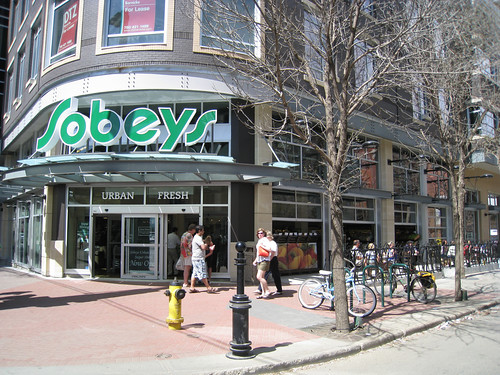Toronto urbanism
One of North America's best urban design writers is Christopher Hume, columnist for the Toronto Star. But I haven't been keeping up with his writing lately because for some reason the daily Toronto Star e-newsletter mostly ends up in my bulk e-mail. Some particularly good columns:
City needs to put its foot down
From the article:
Architecture is important, but planning is crucial. Though Toronto's known for second-rate design, our real problem is poor planning. Throughout the city there are examples, painful examples, of the lack of intelligent planning. The result is not just visual chaos, but a clear feeling that nothing adds up, that nothing makes sense, that the city consists of a growing number of disjointed projects.
-- City life makes big boxes go small or go home on how what matters most isn't building use, but building form, and includes a mention of a Canadian Tire "big box" store on the ground floor of a mixed use building as well as the mention of an Ikea showroom store having opened up on King Street.
-- Grocery chains develop a taste for urban living on the Sobey's Supermarket chain (and others) who are developing true urban grocery stores, smaller, offering smaller quantities, high quality interiors, and a great amount of prepared foods. Sobey's is the second largest supermarket chain in Canada. But they have actually figured out the necessity of offering an "Urban Fresh" sub-brand.

The Sobey's store that has opened in Edmonton, Alberta, featured in this blog entry "Revisiting Sobeys Urban Fresh," from the "Only Here for the Food" blog, has some great images of the quality store provided. The sit-in coffee shop/eat-in area is as attractive as a restaurant (much better than the Whole Foods on P Street NW in DC). (Photo from the OHftF blog.)
-- these two stories reiterate the point I make that urban places need to have appropriately sized urban government services vehicles... "Super-sized fire trucks a poor fit for city streets" and "For fire trucks, bigger isn't better."
--Let's find a better way to plan a city discusses broken planning processes. From the column:
Just as Crown attorneys and defence lawyers call their own friendly expert witnesses in an attempt to win the case at any cost, so developers and opponents hire their experts to bolster their argument, no matter how wrong. What follows can be self-serving if not outright false, but the process allows and encourages such behaviour.
It also favours the rich and powerful over the poor and weak.
In other words, both planning and the law are crude and clumsy ways to make critical decisions. They are systems that can turn even the most intelligent people into dupes and shills.
In the meantime, however, large numbers of professionals now depend for their prestige and livelihood on these antiquated and essentially barbaric processes. Lawyers, as well as psychiatrists, doctors, accountants, land use planners, architects and engineers are the only real winners. The rest of us are the losers.
No, we're not all sentenced to jail for crimes we didn't commit, but the communities we inhabit are slowly but surely being destroyed by a planning regime that doesn't work.
Yet the essence of the urban condition is compromise. Regardless of whatever else the city may be, it represents shared space. It turns all of us into neighbours and, therefore, demands that we learn to coexist.
Because this isn't always easy, dispute resolution mechanisms are crucial. But decision-making mechanisms are equally crucial; none more so than planning.
Labels: retail, supermarkets-groceries, urban design/placemaking



0 Comments:
Post a Comment
<< Home